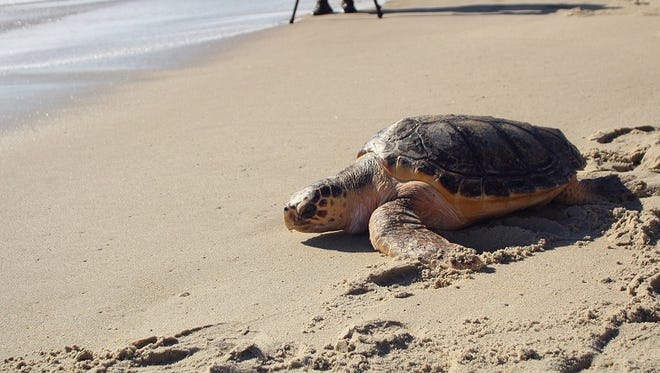Sea turtle's long rehab journey ends with release at Assateague

After an almost yearlong struggle with a lung infection that kept him in rehab and derailed his plans to travel south, Bailey the loggerhead sea turtle lay on the coast of Assateague State Park Thursday, eying his next move.
“You could just see it in his eyes,” said Brandi Biehl, co-executive officer of Sea Turtle Recovery. “He was so happy and ecstatic.”
Biehl and a small group of Sea Turtle Recovery staff members drove the turtle to Assateague from their headquarters in West Orange, New Jersey, where Bailey had been in rehab since May.
In mid-November 2016, Bailey was found floating limp in the Chesapeake Bay, Biehl said.
More:Assateague pony hit by car and killed
According to Erin Bates, a stranding technician at the Virginia Aquarium Stranding Response Program, Bailey was first spotted by a passerby at the bay who reached out to them.
After being alerted, a National Marine Fisheries Observer from the Virginia Aquarium responded first and brought the turtle onto a boat and to the shore, Bates said.
“He was floating pretty listless at the surface,” Bates said.
By the time Bailey was brought to the shore, Bates said the Virginia Aquarium Stranding Response Program arrived and checked the turtle’s vitals.
The response team confirmed Bailey was cold stunned — a term referring to the hypothermic reaction that occurs when sea turtles are exposed to prolonged cold water temperatures.

“When a sea turtle is cold stunned, basically their whole system shuts down,” Biehl said. “At that point, when they are retrieved from the water, you have to warm them up slowly.”
Biehl said symptoms of a cold-stunned turtle include a decreased heart rate, decreased circulation and lethargy. Those symptoms are often followed by shock, pneumonia and potentially death.
Acting fast, the response team transported the turtle to their facility at the Virginia Aquarium to begin treatment.
Bates said that once they stabilized Bailey and began treatment, they discovered the turtle had also caught pneumonia.
“A lot of times, our cold stuns come in with pneumonia," Bates said. "Essentially their immune systems have been compromised and their bodies are shutting down.”
More:Embattled Md. oyster restoration program considered for Manokin, Nanticoke rivers
This set Bailey on a nearly yearlong pathway to recovery that eventually landed the turtle back north to the Sea Turtle Recovery.
By May, Bates said their facility was filling up with an influx of turtles, so they reached out to Sea Turtle Recovery.
“They actually said, ‘If you don’t mind taking three of our loggerheads, that would free up space for more of our turtles coming in,'” Biehl said.
Biehl said they picked up Bailey on their way back from a turtle release in the Carolinas, and began treating the turtle in New Jersey.
By the start of October, Biehl said it was clear that Bailey was ready for another crack at a trip down south.

Biehl said while they initially considered releasing Bailey in New Jersey, they wanted to be sure Bailey would make it south this time.
So, expediting his trip a little, they took Bailey to Assateague State Park.
According to Jennifer Goebel, a public affairs officer at the National Oceanic and Atmospheric Administration, releasing Bailey in Maryland saved the turtle from another bout with cold stun.
“The water temperature is dropping and they wanted to minimize the chances that it'd get caught in these areas and unable to move south to avoid falling temperatures,” she said.
On Thursday, surrounded by a team of Sea Turtle Recovery staff, Bailey, now a healthy 90-pounds and almost 11 years old, moved steadily from the beach and into the water, starting another trip toward the Gulf Stream, Biehl said.
“Out of all the turtles we rehabilitated, I can tell you Bailey has more fight than a lot of the turtles we’ve seen,” she said. “Just to watch a sea turtle that is fully happy go back into the ocean — it’s an incredible feeling.”
More:Chincoteague Pony Penning wins state award for top attraction